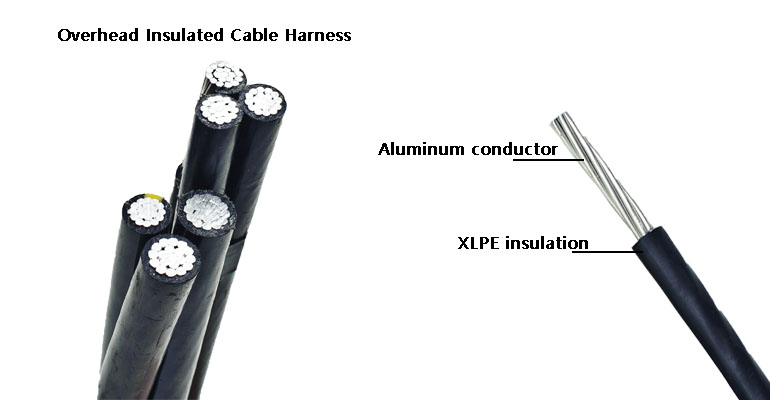- Offices Time:24 Hours Online
- Email:[email protected]
- WhatsApp:+8618339938759

Posted on November 11, 2022
Advantages and disadvantages of overhead insulated cables
Aerial insulated cable is a kind of overhead conductor with insulation layer and protective sheath. It is a special cable manufactured by a production process similar to cross-linked cable. It is a new transmission method between overhead conductors and underground cables. Aerial insulated cables are overhead power transmission equipment with insulating layers and protective sheaths. The product has the characteristics of high strength, good electrical and mechanical properties. Aerial cables are mainly used for large-span power transmission, requiring good electrical performance, corrosion resistance and low cost. Overhead insulated cable products are a new series of products for the transmission of electrical energy from overhead transmission lines, and are preferred for power grid construction and reconstruction of 10kV transmission lines. It is the most suitable series of products for line maintenance and safety.
1.Advantages of overhead insulated cables
(1) The tower structure of the line can be simplified, and it can even be laid along the wall, which not only saves the line material, but also beautifies the city street.
(2) It is conducive to improving and improving the safety and reliability of the power distribution system, greatly reducing the risk of personal electric shock casualties. Insulated conductors can prevent interphase short circuits caused by foreign objects, reduce the number of power outages during the operation of combined pole lines, reduce maintenance workload, and improve The power supply utilization of the line.
(3) Save the power loss of the line and reduce the voltage loss, and the line reactance is only 1/3 of the common bare wire line reactance.
(4) Go deep into the load center at high voltage to improve voltage quality and reduce power loss.
(5) Reduce the gravity requirement of the line, reduce the investment of matching parts, and reduce the labor intensity of workers when they wire.
(6) The space occupied by the overhead line is saved, and it is convenient for the overhead line to pass through the narrow passage. The space occupied by the line is reduced. Compared with the overhead bare line, the space occupied by the line can be reduced by 1/2.
(7) Reduce wire corrosion, thereby correspondingly improving the service life of the line and the reliability of power distribution.
(8) The insulation requirements for line components are reduced, and the number of circuit loops on the same pole is increased. Due to the improvement of the technical condition of the line, the maintenance workload is reduced, the maintenance cycle is prolonged, and the time of power failure due to maintenance is reduced.

2.Disadvantages of overhead insulated cables
(1) The allowable current carrying capacity of the high-voltage insulated overhead wire is smaller than that of the bare wire, because the heat dissipation of the wire is poor after the plastic layer is added, and the overhead insulated wire should usually be modeled by a grade higher than usual. To match to 95mm2.
(2) The wire diameter of the high-voltage insulated overhead wire is larger, and the plastic sheath is added, and the wire diameter is one grade larger than that of the steel core aluminum stranded wire with the same cross section. Although insulated wires have many advantages, the unit cost is higher than that of bare wires, about twice as much for medium-voltage lines, and about 25% for low-voltage lines.
3.Environmental requirements for overhead insulated cables
(1) When laying the cable, the ambient temperature should not be lower than -20°C, and when laying below -20°C, the cable must be preheated.
(2) When laying overhead cables, the bending radius of the rated voltage 1kV overhead insulated cable should not be less than 6 times the outer diameter of the cable, and the 101kV and 35KV overhead insulated cables should not be less than 15 times the outer diameter.
(3) The erection method of the cable, the same as the bare overhead line, still needs to be fixed on the insulator of the cross arm, but the distance can be appropriately reduced.
(4) The cables should be used together with specially designed overhead insulated cable metal appliances.
(5) During the laying and storage process, attention should be paid to the sealing of the cable end to prevent the cable from entering water and reducing its performance.
(6) The long-term operating temperature of overhead cables that is the long-term allowable working temperature of the conductive core of the cable), the cross-linked polyethylene insulation should not exceed 90 °C, the high-density polyethylene insulation should not exceed 75 °C; the polyethylene and polyvinyl chloride insulation should not exceed 90 °C. Over 70℃; XLPE insulation should not exceed 250℃ during short circuit; HDPE and PVC insulation should not exceed 150℃, and the longest duration should not exceed 5 seconds.
Jinshui Wire&Cable Group specializes in the production of overhead insulated cables and overhead bare wires. In the continuous improvement and development of technology, we have strong innovation capabilities, and have a number of patented technologies, and have established long-term good cooperative relations with many countries.
Post categories
Most Popular Posts
-
The 136th Canton Fair welcomes you to participate!
October 12, 2024 -
High temperature cable introduction
July 26, 2024 -
Kenya Power and Energy Exhibition 2024
June 11, 2024 -
Introduction of rubber sheathed cable
June 5, 2024





